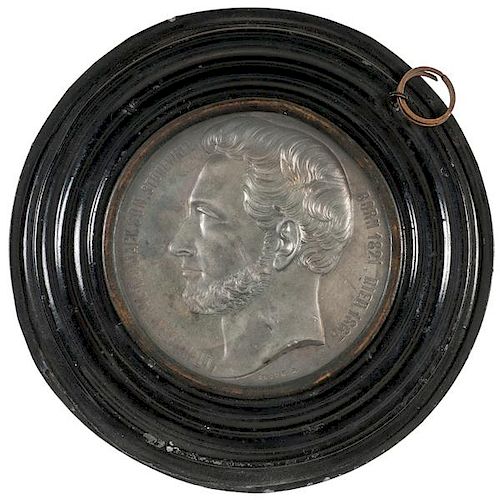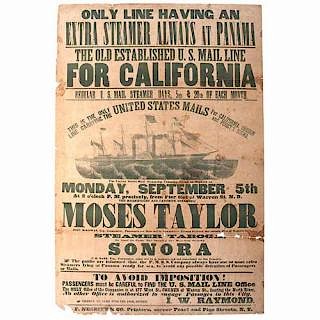Stonewall Jackson Medal, 1863, Struck in France for Distribution to the Stonewall Brigade
About Seller
6270 Este Ave.
Cincinnati , OH 45232
United States
With offices in Cincinnati, Cleveland and Denver, Cowan’s holds over 40 auctions each year, with annual sales exceeding $16M. We reach buyers around the globe, and take pride in our reputation for integrity, customer service and great results. A full-service house, Cowan’s Auctions specializes in Am...Read more
Two ways to bid:
- Leave a max absentee bid and the platform will bid on your behalf up to your maximum bid during the live auction.
- Bid live during the auction and your bids will be submitted real-time to the auctioneer.
Bid Increments
| Price | Bid Increment |
|---|---|
| $0 | $25 |
| $500 | $50 |
| $1,000 | $100 |
| $2,000 | $250 |
| $5,000 | $500 |
| $10,000 | $1,000 |
| $20,000 | $2,500 |
| $50,000 | $5,000 |
| $100,000 | $10,000 |
About Auction
Jun 10, 2016 - Jun 11, 2016
Cowan's Auctions dawnie@cowans.com
- Lot Description
Stonewall Jackson Medal, 1863, Struck in France for Distribution to the Stonewall Brigade
Lot of 2, featuring 1863 medal likely struck in white metal, 2 in. dia., housed in an original black case under glass, 3.5 in. dia. The medal shows a right facing bust of General Stonewall Jackson on the front with the inscription, LIEUT, GENERAL T. J. JACKSON. STONEWALL and BORN 1821. Died 1863. General Jackson was actually born in 1824. Below the head, in small letters, is CAQUE.F, the signature of the die engraver. Inscribed on the reverse, DEO VINDICE, surrounded by wreath of tobacco and corn stalks with a small trophy of arms at the bottom, a shield, and a list of all his battles, although there are some inaccuracies in the battles referenced. The maker’s name, MASSONNET EDITUR, appears in small letters at the bottom of the reverse. Accompanied by note, likely written by Bessie Johnston Gresham, which reads:
Directly after the death of Stonewall Jackson Confederates in Paris (among them Edward Lee Child son of Genl Lee’s sister who had moved & lived there) had memorial medals of Jackson prepared to be presented to the Stonewall Brigade. These medals were run the blockade to Gassanay B. Lamar by a wealthy gentleman of Georgia, and a few years ago [1894] the box containing them was discovered in the garret of the Custom House at Savannah. Through Mrs. Lamar they came to us in Maryland.
Given to me by Capt. Pope Superintendent Confederate Home Baltimore – Feb 20th 1899.
The Lamar family to whom the medals belonged, turned over the entire stock to the Ladies’ Auxiliary of the Confederate Veteran’s Association of Savannah, to be sold for the benefit of Confederate veterans.
Bessie E. Johnston Gresham Collection of Confederate Manuscripts, Photographs, & Relics
Lots 89-115
Bessie E. Johnston Gresham was born in Baltimore, MD in 1848 in a home sympathetic to the Southern cause. Union forces imprisoned one of her brothers for aiding the South, and her brother Elliott was a Confederate officer who lost a leg at the battle of Antietam. She became an ardent and unreconstructed Confederate, and, in 1887, she married Thomas Baxter Gresham, a Confederate veteran from Macon, GA. She was actively involved in the Baltimore chapter of the United Daughters of the Confederacy, and amassed a notable collection of Confederate manuscripts, photographs, and relics at the Gresham home at 815 Park Avenue in Baltimore. Most of her items were left to the Museum of the Confederacy, the Maryland Historical Society, and other institutions. This important collection of Johnston-Gresham family and Confederate-related material, was passed down through Bessie Johnston Gresham’s step-son, Leroy Gresham, before it was acquired by the consignor.
The collection features over 50 CDVs accumulated by Bessie and Thomas Gresham, offered as Lots 89-100. Some are wardate, and others were apparently acquired in Baltimore soon after the war's end. Some CDVs include patriotic inscriptions and quotations written by Bessie on reverse, which showcase her deep feeling of love and devotion to the Southern Cause.
In a June 1862 letter delivered through the Union blockade, Elliott Johnston, serving as aide-de-camp to CSA General Richard B. Garnett, mentioned collecting photos of CSA generals for his then 14-year-old sister Bessie.
In a 1926 issue of Confederate Veteran magazine, a memorial essay described Bessie's girlhood during the war:
"One of her brothers, who was on General Ewell’s staff, suffered the loss of a leg at the battle of Sharpsburg; her two other brothers were active Southern sympathizers and were under constant surveillance by Federal authorities for giving all possible aid to the Confederacy; her home was a center from which radiated help. “
"Reared in this atmosphere of deep love for our ‘cause,’ she became an ardent and unreconstructed Confederate. "
During her girlhood, Bessie was acquainted with many Southern generals and received from them letters, photographs, and autographs, as well as a number of gifts.The medal is in good condition, although the glass is loose. The note is in rather poor condition, brittle, chipped around edges. However, it is legible.Condition
- Shipping Info
-
SHIPPING. At the request of the buyer, Cowan's will authorize the shipment of purchased items. Shipments usually occur within two weeks after payment has been received. Shipment is generally made via UPS Ground service. Unless buyer gives special instructions, the shipping method shall be at the sole discretion of Cowan's Auctions, Inc.. Cowan's is in no way responsible for the acts or omissions of independent handlers, packers or shippers of purchased items or for any loss, damage or delay from the packing or shipping of any property.
-
- Buyer's Premium



 EUR
EUR CAD
CAD AUD
AUD GBP
GBP MXN
MXN HKD
HKD CNY
CNY MYR
MYR SEK
SEK SGD
SGD CHF
CHF THB
THB












